
Sonic Heroes is a 2003 platform game developed by Sonic Team USA and published by Sega as part of the Sonic the Hedgehog series. The player races a team of series characters through levels to amass rings, defeat robots, and collect the seven Chaos Emeralds needed to defeat Doctor Eggman. Within each level, the player switches between the team's three characters, who each have unique abilities, to overcome obstacles. Sonic Heroes downplays the action-adventure and exploration-based gameplay of its predecessors Sonic Adventure (1998) and Sonic Adventure 2 (2001) in favor of returning to the linear style of Sega Genesis-era Sonic games.

Sonic & Knuckles is a 1994 platform game developed and published by Sega. Players control Sonic the Hedgehog or Knuckles the Echidna in their quests to save Angel Island; Sonic tries to stop Doctor Robotnik from re-launching his orbital weapon, the Death Egg, while Knuckles scuffles with Robotnik's minion, EggRobo. Like previous Sonic games, players traverse side-scrolling levels at high speeds while collecting rings and defeating enemies.
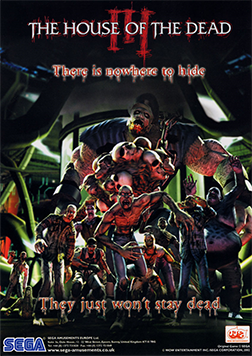
The House of the Dead III is a 2002 horror-themed light gun arcade game and the third installment of the House of the Dead series of video games, developed by Wow Entertainment and Sega. It was ported to the Xbox in 2003, Microsoft Windows in 2005, the Wii in 2008 in a compilation with The House of the Dead 2, and PlayStation 3 in 2012 with PlayStation Move support. The game was remade with typing controls as The Typing of the Dead 2 in 2008. The game continues the story of the previous games and introduces new gameplay concepts. The game's secondary protagonist is Lisa Rogan, daughter of Thomas Rogan and Sophie Richards.

Glover is a 1998 puzzle-platformer developed by Interactive Studios and published by Hasbro Interactive for the Nintendo 64 and Windows in 1998, and for the PlayStation in 1999. The game follows a magical, four-fingered glove named Glover in his quest to restore the Crystal Kingdom by retrieving crystals that were lost. The Nintendo 64 and Windows versions received generally positive reviews while the PlayStation version garnered negative reviews. A sequel titled Glover 2 was planned but was eventually cancelled. A second updated Windows port was released in 2022 and a port for Nintendo Switch, PlayStation 4, PlayStation 5, Xbox One, and Xbox Series X/S is in development.

Lego Star Wars: The Video Game is a 2005 Lego-themed action-adventure video game based on the Lego Star Wars line of construction toys, and the first installment in the Lego video game franchise developed by Traveller's Tales, which would develop all future Lego titles from that point on. It was first released on 29 March 2005, and is a video game adaptation of the Star Wars prequel trilogy: The Phantom Menace, Attack of the Clones and Revenge of the Sith, with a bonus level from A New Hope.

Worms 3D is a 2003 3D artillery turn-based tactical video game developed by Team17 and published by Sega, Acclaim Entertainment, and Feral Interactive. It is the sixth installment in the Worms series, and was released for GameCube, Mac OS X, Microsoft Windows, PlayStation 2 and Xbox. Notably, the game was the first in the series to be fully 3D. Additionally, it featured several new weapons, with some weapon operations being substantially different from previous Worms titles.

Batman: Vengeance is a 2001 action-adventure video game based on the fictional superhero of the same name. It was released for PlayStation 2, Game Boy Advance, GameCube, Xbox and Microsoft Windows. The game was developed and published by Ubi Soft in conjunction with Warner Bros. and DC Comics.

Sheep is a strategy puzzle video game released for PlayStation, Microsoft Windows and Game Boy Advance. In 2001 it was released for Mac OS X by Feral Interactive. The Game Boy Advance version was supposed to be released in North America in the spring of 2002, but was canceled for unknown reasons.

Curious George is a 2006 platform game published by Namco, and developed by Monkey Bar Games, a division of Vicious Cycle Software. It was released for the GameCube, PlayStation 2, Xbox, and Microsoft Windows, and is based on the 2006 film of the same name. A separate 2D version was developed for the Game Boy Advance (GBA) by Torus Games. Most of the animated film's original voices were not used in any of the in-game dialogue, except for the cutscenes, while Frank Welker and David Cross reprise their roles as Curious George and Junior respectively.

Marvel: Ultimate Alliance is a 2006 action role-playing video game, developed by Raven Software for the PlayStation 2, PlayStation 3, Xbox and Xbox 360, and published by Activision. The game was ported to the PlayStation Portable and Wii by Vicarious Visions, and to Microsoft Windows by Beenox. A different Game Boy Advance version was developed by Barking Lizards Technologies. A re-release version based on Xbox 360's latest edition was ported by Zoë Mode for Windows, PlayStation 4, and Xbox One, and was released in July 2016.
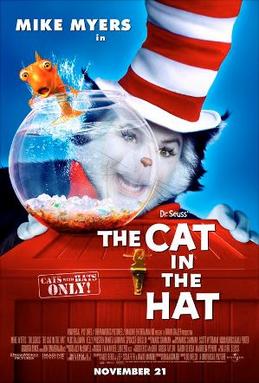
The Cat in the Hat is a 2003 American fantasy comedy film directed by Bo Welch in his directorial debut and written by Alec Berg, David Mandel and Jeff Schaffer. Loosely based on Dr. Seuss's 1957 book of the same name, it was the second and final live-action feature-length Dr. Seuss adaptation after How the Grinch Stole Christmas (2000). The film stars Mike Myers in the title role along with Alec Baldwin, Kelly Preston, Dakota Fanning, Spencer Breslin, Amy Hill and Sean Hayes in supporting roles.

Catwoman is an action-adventure video game based on the 2004 film of the same name based on the fictional character. It features the likeness of the film's lead actress Halle Berry, while the character's voice is provided by actress Jennifer Hale. This would end up being developer Argonaut Software's final game.
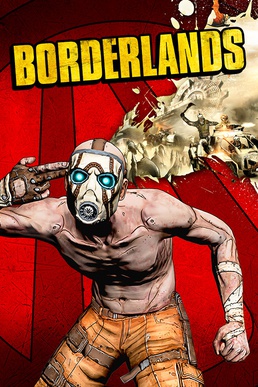
Borderlands is a 2009 action role-playing first-person shooter video game developed by Gearbox Software and published by 2K. It is the first game in the Borderlands series. The game was released worldwide in October 2009 for the PlayStation 3, Xbox 360 and Microsoft Windows, with a Mac OS X version being released on December 3, 2010 by Feral Interactive. The game's story focuses on a group of four "Vault Hunters", who travel to the distant planet of Pandora to search for the "Vault", which is rumored to contain advanced alien technology and other priceless riches. The hunters piece together clues to find the Vault while battling the savage wildlife of Pandora, local bandits that populate the planet, and ultimately banding together to prevent the Atlas Corporation and its privately funded paramilitary forces from reaching the Vault first.

Deathsmiles is a horizontally scrolling shooter arcade video game by Japanese developer Cave, released in late 2007. It has heavy occult and gothic influences. It is the second Cave shooter to be played using a horizontally-oriented monitor. It was the first Cave shooter released in North America on a console, and the first one in Europe. Cave has also released it for iOS. A sequel, Deathsmiles II, was released to Japanese arcades on May 14, 2009. A compilation of both Deathsmiles I and Deathsmiles II was released for PlayStation 4, Xbox One and Nintendo Switch in Japan on December 16, 2021.

Risen is an action role-playing game developed by the German company Piranha Bytes and published by Deep Silver. The first title in the Risen series, it was released internationally for Microsoft Windows and Xbox 360 in October 2009, with a North American release for Xbox 360 in February 2010. Ports for the PlayStation 4, Xbox One and Nintendo Switch were released in January 2023.
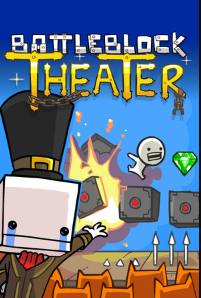
BattleBlock Theater is a comedic platform game developed by The Behemoth and published by Microsoft Studios for Xbox 360, Windows, Mac, and Linux. It is the third title from The Behemoth following Alien Hominid and Castle Crashers. The game was released on Xbox Live Arcade on April 3, 2013, and later temporarily made free via Games with Gold on July 16, 2014.
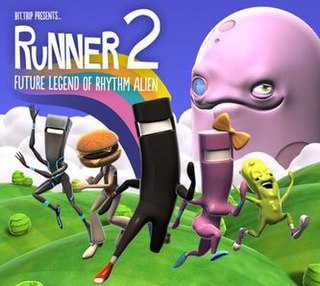
Bit.Trip Presents... Runner2: Future Legend of Rhythm Alien, generally shortened as Runner2, is a 2013 side-scrolling platformer developed by Gaijin Games. The game is the direct sequel to Bit.Trip Runner and has been released as a downloadable title available on the PlayStation 3, PlayStation Vita, Xbox 360 and Wii U consoles, Microsoft Windows, OS X, Linux and on iOS, as well as PlayStation 4 in 2016 and Nintendo Switch in 2024. The PC, Mac, Linux, and Wii U versions were self-published by Gaijin Games, and the Xbox 360 and PlayStation 3 versions were published by Aksys Games.
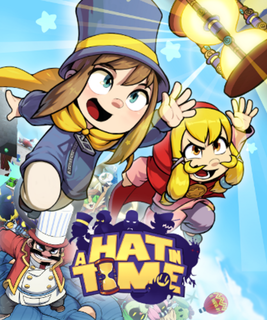
A Hat in Time is a 2017 platform game developed by Danish game studio Gears for Breakfast and published by Humble Bundle. The game was developed using Unreal Engine 3 and funded through a Kickstarter campaign, which nearly doubled its fundraising goals within its first two days. The game was self-published for macOS and Windows in October 2017, and by Humble Bundle for the PlayStation 4 and Xbox One consoles two months later. A version for the Nintendo Switch was released in October 2019.
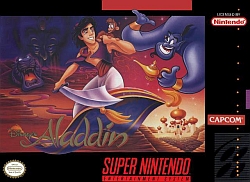
Disney's Aladdin is a 1993 platform game developed and published by Capcom for the Super Nintendo Entertainment System, based on the 1992 animated Disney film of the same name. Disney's Aladdin is a 2D side-scrolling video game in which the player controls Aladdin and his monkey Abu. It was designed by Shinji Mikami.



















